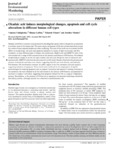Mostrar o rexistro simple do ítem
Okadaic Acid Induces Morphological Changes, Apoptosis and Cell Cycle Alterations in Different Human Cell Types
| dc.contributor.author | Valdiglesias, Vanessa | |
| dc.contributor.author | Laffon, Blanca | |
| dc.contributor.author | Pásaro, Eduardo | |
| dc.contributor.author | Méndez, Josefina | |
| dc.date.accessioned | 2024-01-10T16:41:45Z | |
| dc.date.available | 2024-01-10T16:41:45Z | |
| dc.date.issued | 2011-03-28 | |
| dc.identifier.citation | V. Valdiglesias, B. Laffon, E. Pásaro and J. Méndez, Okadaic acid induces morphological changes, apoptosis and cell cycle alterations in different human cell types, J. Environ. Monit., 2011,13, 1831-1840, https://doi.org/10.1039/C0EM00771D | es_ES |
| dc.identifier.issn | 1464-0333 | |
| dc.identifier.uri | http://hdl.handle.net/2183/34802 | |
| dc.description | This version of the article has been accepted for publication, after peer review, but is not the Version of Record and does not reflect post-acceptance improvements, or any corrections. The Version of Record is available online at: https://doi.org/10.1039/C0EM00771D | es_ES |
| dc.description.abstract | [Abstract] Okadaic acid (OA) is a marine toxin produced by dinoflagellate species which is frequently accumulated in molluscs usual in the human diet. The exact action mechanism of OA has not been described yet and the results of most reported studies are often conflicting. The aim of this work was to evaluate the OA effects on morphology, cell cycle and apoptosis induction by means of light microscopy and flow cytometry, in three different types of human cells (leukocytes, HepG2 cells and SHSY5Y cells). Cells were treated with a range of OA concentrations in the presence and absence of S9 fraction. OA induced morphological changes in all the cell types studied, and cell cycle disruption only in leukocytes and neuronal cells. SHSY5Y cells were the most sensitive to OA assault. Results obtained in the presence and absence of metabolic activation were similar, suggesting that OA acts both directly and indirectly. Furthermore, OA was found to increase the subG1 region in the flow cytometry cell cycle analysis, suggesting induction of apoptosis. These results were confirmed by the employment of specific methodologies for studying apoptosis such as caspase 3 activation and annexin V staining. Increases in the apoptosis rate were obtained in all the cells treated in the absence of S9 fraction, accompanied by increases in caspase 3 activation, suggesting that apoptosis induced by OA is a caspase 3-dependent process. Nevertheless, in the presence of S9 fraction no apoptosis was detected, indicating a metabolic detoxifying activity, although necrosis was observed in neuroblastoma cells. | es_ES |
| dc.description.sponsorship | This work was funded by a grant from the Xunta de Galicia (INCITE08PXIB106155PR). V. Valdiglesias was supported by a fellowship from the University of A Coruña | es_ES |
| dc.description.sponsorship | Galicia.Xunta; INCITE08PXIB106155PR | es_ES |
| dc.language.iso | eng | es_ES |
| dc.publisher | Royal Society of Chemistry (Gran Bretaña) | es_ES |
| dc.relation.uri | https://doi.org/10.1039/C0EM00771D | es_ES |
| dc.title | Okadaic Acid Induces Morphological Changes, Apoptosis and Cell Cycle Alterations in Different Human Cell Types | es_ES |
| dc.type | info:eu-repo/semantics/article | es_ES |
| dc.rights.access | info:eu-repo/semantics/openAccess | es_ES |
| UDC.journalTitle | Journal of Environmental Monitoring | es_ES |
| UDC.volume | 13 (2011) | es_ES |
| UDC.issue | 6 | es_ES |
| UDC.startPage | 1831 | es_ES |
| UDC.endPage | 1840 | es_ES |
| dc.identifier.doi | 10.1039/C0EM00771D |






